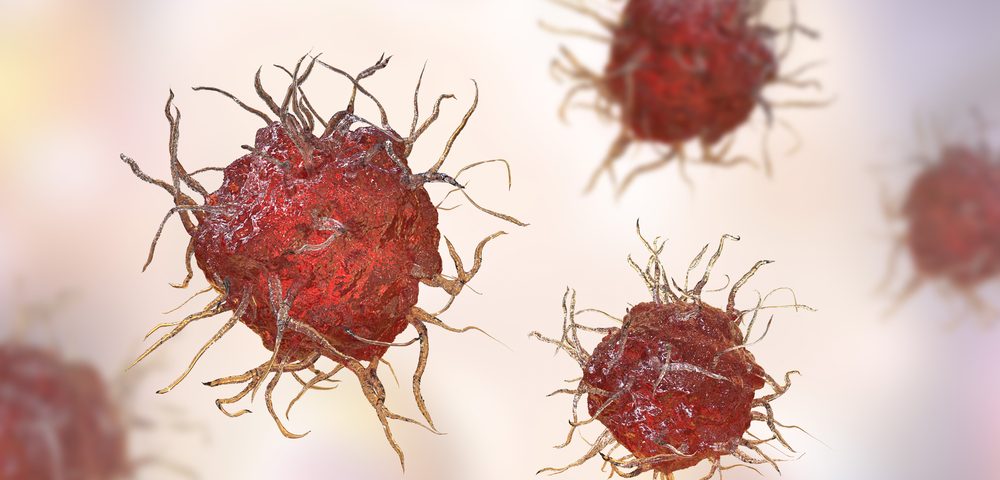A combination of Forty Seven‘s macrophage checkpoint inhibitor Hu5F9-G4 and Rituxan (rituximab) is safe and completely eliminated tumors in one-third of non-Hodgkin’s lymphoma patients included in a Phase 1b trial.
The trial, which included patients with diffuse large B-cell lymphoma (DLBCL) or follicular lymphoma who had failed prior treatments, also showed that half of patients saw their tumors shrink.
Findings were recently published in the New England Journal of Medicine, in the study, “CD47 Blockade by Hu5F9-G4 and Rituximab in Non-Hodgkin’s Lymphoma.”
“While newer therapies have shown robust activity in r/r NHL [relapsed or refractory non-Hodgkin’s lymphoma], there remains an unmet need for new medicines that are both well-tolerated and able to induce clinically meaningful responses in patients who need urgent treatment,” Sonali Smith, MD, senior author of the study, said in a press release.
“The publication of these Phase 1b data in the NEJM underscores the potential of CD47 inhibition as a novel approach to treating cancer, and reinforces the strong therapeutic potential of 5F9 as a safe and efficacious option for patients with r/r NHL,” added Smith, who is also the Elwood V. Jensen Professor in Medicine and director of the Lymphoma Program at the University of Chicago Medicine.
The mainstay treatment for virtually all B-cell non-Hodgkin’s lymphomas includes CD20-targeting antibodies such as Rituxan. However, once patients become resistant to these therapies, their prognosis is poor, with only a few months to live.
Treatments that improve the effectiveness and durability of Rituxan are needed, and studies suggest that blocking CD47 to activate macrophages might be one possible approach.
Macrophages are immune cells that engulf invaders and participate in the fight against cancer, but cancer cells often produce the CD47 protein as a “don’t eat me” signal. Thus, Forty Seven developed Hu5F9-G4 — or just 5F9 — an antibody that targets CD47 and improves the ability of macrophages to identify cancer cells and eliminate them.
The ongoing Phase 1b/2 trial (NCT02953509) was designed to study the safety and efficacy of 5F9 in combination with Rituxan in non-Hodgkin’s lymphoma patients who had failed at least two prior treatment approaches.
It is being conducted in collaboration with the Leukemia & Lymphoma Society, and is still recruiting, aiming to enroll 72 participants across 11 clinical sites in the U.S. and U.K.
In the trial’s Phase 1b part, researchers tested several 5F9 doses to determine which had the best safety and efficacy results in combination with Rituxan. This phase included 22 patients, at a median age of 59 years, who had received a median of four previous lines of therapy. Most of these patients (95%) had failed to respond to prior Rituxan-based therapies.
Patients first received a 5F9 dose of 1 mg per kilogram of body weight, and were then given escalating weekly doses — 10, 20, or 30 mg per kilogram — of the treatment until their disease progressed or toxic effects appeared. Rituxan (375 mg) was administered weekly in the first four-week cycle, and monthly thereafter until cycle six.
Overall, 50% of patients responded to the combination, including 36% complete responses. Among DLBCL patients, the response rate was 40%, with 33% complete responses. For those with follicular lymphoma, the figures were 71% and 43%.
After a median follow-up of 6.2 months for DLBCL and 8.1 months for follicular lymphoma, 10 of the 11 responders (91%) had an ongoing response.
Most adverse events were mild to moderate in severity, and included chills, headache, anemia, and infusion-related reactions. Most occurred within the first few weeks without long-term toxic effects.
The 30 mg dose led to the inhibition of virtually all CD47 proteins in white and red blood cells and was selected for further testing in the Phase 2 part. This part is currently ongoing, and researchers will be testing 5F9 in patients with DLBCL and indolent lymphoma.
“I look forward to continuing to evaluate 5F9 in combination with rituximab in patients with diffuse large B-cell lymphoma (DLBCL) and follicular lymphoma (FL) in the Phase 2 portion of this clinical trial,” Smith said.
In May, 5F9 received fast track designation from the U.S. Food and Drug Administration for relapsed or refractory DLBCL and follicular lymphoma. It is also being studied as a treatment for solid tumors, acute myeloid leukemia, ovarian cancer, and colorectal carcinoma, both alone and in combination with other treatments.
“We are encouraged by the publication of this manuscript in the NEJM, which is among the first clinical data with a CD47-targeting antibody to be published in a major medical journal,” said Mark McCamish, MD, PhD, president and CEO of Forty Seven.
“This publication further supports Forty Seven’s pioneering role in the development of a new class of immunotherapies, and to the potential of macrophage activation to induce meaningful clinical responses,” McCamish added. “We are committed to leveraging our deep understanding of the CD47/SIRPα pathway to help patients more effectively defeat their cancer and are eager to advance our broad 5F9 development program forward.”


